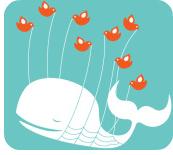How to dive into Web 2.0 social media culture
Today was my first day teaching Content Development for Web Pages or MASS 410 as it is described in the Mesa State College course catalog.
The catalog defines the course as:
Developing content for the World Wide Web for small businesses, non-profit organizations and media from a public relations perspective.
Development of content for public relations, advertising, marketing and sales, academic and news web sites. Electronic publications and on-line publishing policies and procedures. Methods of electronic journalism.

I began the class by explaining that the class would not be a web design class. There were a buzz of joy. Only one student said she was disappointed that I would not be teaching how to design web pages.
The class seemed a little confused as I explained that they would develop websites, post articles, upload video and audio without learning how to design websites.
I handed out a list of terms that would help them settle into the Web 2.0 and social media world. Most of them were only able to define about six or eight of these terms – even though I let them work with a partner.
Blog, Podcast, iTunes, Blogger, Wordpress, RSS, Aggregator, Mashup, Social Media, Facebook, MySpace, Twitter, TweetDeck, iGoogle, Google Docs, Fanboy, Firefox, Google Chrome, Web host, Relevance, Adsense, CNET, Hotspot, Web 2.0, Fail, Rickroll, pwned, Urban Dictionary, Social Bookmarking, Tags, Wiki, App, Tweetup, Viral, Fail Whale, Extensions, The Cloud, YouTube, Delicious, Domain, URL, Internet Explorer, Safari, Adam Curry, Digg, TED.
I chose these terms because they span the entire spectrum of Web 2.0. While I expected that not everyone would know all the terms, I was a little surprised to find that only terms like iTunes, Blog and Facebook were defined my most of the students. The class had roughly 30 students.
Having been the guy who worked in radio as the stations were adopting computer automated programming and having worked for a newspaper during the transition from literal cut and paste to digital upload of layout, I am now excited to help students make the transition to the “new media.”
Contrary to popular belief, college students are still new to social media and productive use of the Internet. Sure, they understand how to find music on MySpace, poke their friends on Facebook and some of them even tweet what they are eating for lunch. But, that is not productive use of social media.
There is a good chance, that everyone who reads this article will be familiar with social media. It is interesting though to see how little the concept of social media has caught on. I hope to help this class gain an appreciation and respect for social media. When I asked where the Hudson plane crash stories first broke, students shouted out their answers of CNN, MSNBC, etc. As I explained that the stories broke in the social media first, it was excellent to see the lights come on as they realized that social media can actually be part of The Media. Unlike traditional media, social media becomes news media when we use it as news media.
Very cool…good luck with the 30 minds!Sounds fun.